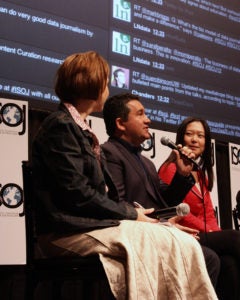April 21, 2012 | Ethics, Mobile Journalism, Multimedia, Research, Social Media
Reading Readers: Research on the News Community
Audience preference and editorial judgment: A study of time-lagged influence in online news
Angela M. Lee, University of Texas at Austin and Seth C. Lewis, University of Minnesota
Through data analysis of three online papers — The New York Times, the New York Post, and the New York Daily News — Lee and Lewis found that audience news preferences do indeed affect the way editors arrange content on their homepage, contrary to the original idea of elite media as ‘agenda setters.’
Instead of mainstream editors deciding the placement and importance of news stories throughout the day, the study revealed that the audience’s news preferences shaped the way the content was displayed three hours later. Essentially, if one topic was trending within the audience, the three studied papers were found to post related content on that subject or event within three-hour intervals.
Lee added that editorial judgment — the placement of news online — does not have this vice-versa, time-lagged affect on the audience.
The study ultimately left an open-ended question: As we study the role of editors in the age of data, is there a rise in audience power?
“We don’t really know the answer,” Lee said. “One possibility is that online, speed is important. It’s all about immediacy. We have to make room for fresher content, but qualitative studies will also help.”
Sourcing the Arab Spring: A case study of Andy Carvin’s sources during the Tunisian and Egyptian revolutions
Aflred Hermida, University of British Columbia (Canada), Seth C. Lewis, University of Minnesota, Twin Cities and Rodrigo Zamith, University of Minnesota, Twin Cities

Hermida and his team studied NPR reporter Andy Carvin’s Twitter activity during the 2011 Tunisian and Egyptian uprisings to analyze how journalists give privilege to the mainstream media when they seek out their sources.
He turned to the projection screen, guided our eyes to the image of suit-clad Americans and said, “These people are an example of our dominant sourcing: nice, smiley politicians.”
However, after analysis of Carvin’s tweets, the study showed a broader range of alternative, rebel voices represented in that social sphere.
The activity was coded into four source types
1. Mainstream media
2. Institutional elites
3. Alternative voices
4. Other non-affiliated, activist bloggers and organizations
The team’s research found that when they focused on the frequency of Carvin’s tweets during the Tunisian and Egyptian revolutions, they found a reversal of traditional patterns of sourcing. Carvin chose not discredit, but amplify the alternative voices instead of privileging the institutional elites.
“The role of the journalist will be as a node curator,” Hermida said. “You’ll synthesize events in real time, participate in collaborative reporting involving a whole range of voices, and you’ll be trusted to interpret and contextualize on social network streams.”
Who knows best? Attitudes and perceptions of citizen journalism and the news through the lens of creators and consumers
Avery Holton, Mark Coddington, and Homero Gil de Zuniga, University of Texas at Austin
As digital journalism evolves so do the roles, attitudes, motivations and opinions of participatory journalists.
The research connected participants’ behavior, how they perceived their own role in this new form of journalism, and it studied if citizen journalists adhered to the traditional values of journalism (autonomy, accuracy and objectivity).
Research showed that the distinction between content creators and consumers might not be as important as the distinction between news consumers and consumers of citizen journalism.
“Those who consume citizen journalism may have the best attitudes about it but they don’t identify with the traditional tenets,” Coddington said. “Those who consume news generally may best identify with tenets of professional journalism, more than those who create content.”
Coddington also said that they found that some citizens are participating in this form of journalism without it being a conscious effort.
“We’d expect a line between creating content and values,” Coddington said. “Those who create content might just create. It’s not journalism to them it becomes a way of life. It’s not seen as journalism. It could be a good thing.”
Asserting “truth” in political debates: A study of partisan Twitter users
Emily T. Metzgar and Hans P. Ibold, Indiana University
Metzgar and team worked with Truthy to analyze the tweets of two political hashtag communities- #tcot and #p2 to visualize the differences in the ways the left and right contribute to the political dialogue.
The study found that Tweets consisting entirely of retweets were more likely to be associated with the left.
Regardless of the political alignment, the tweets tended to be sandal-oriented and emotionally charged.
There was an overall disregard for verification in the tweets, regardless of partisan orientation.
Links to the outside of tweets tended to shift toward assisting with verification.
Content Curation: A new form of gatewatching for social media?
Katarina Stanoevska-Slabeva, Vittoria Sacco, and Marco Giardina of Neuchâtel (Switzerland)
Gatewatching — versus the traditional journalist’s role of gatekeeper — is social media curation where participants select relative content to tell a digital narrative. (e.g, Storify)
The study used the Storify platform and 450 of it’s stories pertaining to the Arab Spring (between January 2011 to August 2011) to identify the sources that contributed to these digital narratives as well as to more clearly define this new concept of gatewatching.
The study identified sources involved in the social media curation that documented the Arab Spring including mainstream media organizations, citizens, officials, non-profit organizations, Non-Arab people, Arab people and other sources that were unknown.
The analyzed content showed that Storify altered the levels of gates and the way information is diffused and received. Whether you’re an amateur author or a media professional, Storify levels the curation field, and any user is now welcome to publish to an infinite, increasingly attentive audience.
ISOJ 2012: “New Approaches” Q&A panel during the 13th Online Symposium on Online Journalism from Knight Center on Vimeo.

